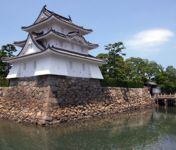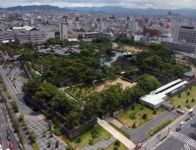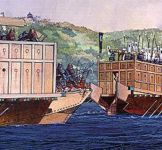ODA NOBUNAGA'S
OTHER WARS
IN
CHRONOLOGICAL ORDER
Click here for detailed and complete maps of Japan, all the provinces and warlords.
| PAGE 1 | PAGE 2 |
In 1578, Toyotomi Hideyoshi's forces, backed-up by Oda Nobutada's, putting up camps around the castle of Miki in the domain of Mori Terumoto's. Two times of New Year had passed since, and they were still there at the same camps. Commander of Miki, Lord Bessho Nagaharu, had been able to hold on for so long, frustrating the Oda Army. Bessho was Oda Nobunaga's ally before, though only for a very short time. He used to be what he was at the time of Toyotomi's siege; a staunch supporter of the Mori clan. He switched back to Mori after Oda's own General Araki Murashige of Itami rebelled earlier in 1578 (click here) -- maybe Bessho thought Oda wasn't good enough to follow, since his own man was against him like that. The Mori clan would never let this one castle to fall, of that everyone was sure. Miki was Mori's vital stronghold, blocking enemies' way into the only passable entrance to the center of his domain. It was a river-circling castle, and the Oda Navy under Admiral Kuki Yoshitaka's command couldn't always intercept shipments of supplies from Mori to Bessho, while these ships never touched land at all so the massive Oda Army couldn't lay their hands on them either. Toyotomi's strategy was typical of sieges -- he slowly ("Too darn slowly!" shouted Oda Nobunaga who was waiting far away in Azuchi) cut off the outlaying fortresses around Miki. This meant reducing the defense of the castle, and in this process Bessho Nagaharu's home was destroyed and his brother died there. But the news, fluttered by Toyotomi in his usual way (more like a TV commercial), didn't shake Bessho at all. He politely but firmly kept on refusing to even talk about peace. Meanwhile, Admiral Kuki tightened his naval blockade. More and more ships sent by Mori never reached their destination at Miki. On land, Toyotomi perfectly encircled this castle, cutting it off from the rest of the planet completely. Still Bessho Nagaharu didn't respond to the urge to surrender. Day by day Toyotomi woke up hoping that it would be the last day of the super-long siege, only to be let down by Bessho again. Inside the castle, Bessho's men had started to eat anything that lived. Still no surrender. They'd rather starve. Only their General couldn't shut his conscience up upon the prospect of having all his men to die starving. Bessho finally let his Captain, Goto Motokuni, to meet with the Oda Captain Kuroda Kanbei when Goto's soldiers had even boiled and eaten floor mattresses (no kidding; the Japanese 'tatami' is made of natural fibers). The two negotiated Miki's surrender -- an unconditional one, because, no matter what Kuroda might have thought, that was the way Oda Nobunaga wanted it to be. Kuroda agreed to take care of Goto's son, Goto Matabei, and promised the father that he would raise the kid with his own son (click here for the political misadventure of Araki Murashige's, that caused Oda Nobunaga's order to behead Kuroda Kanbei's son -- and how this was solved by Takenaka Hanbei). The next day, everybody who were Somebody inside the castle of Miki committed suicide. The famous warriors of Western Japan, Bessho Motoharu and Goto Motokuni, were to be no more since 1580. Toyotomi, who basically loved kids, made sure the promise to Goto Motokuni was fulfilled.
In 1615, it was Goto Matabei's turn to help Toyotomi Hideyoshi's son, Hideyori, to defend the Osaka castle from Tokugawa Ieyasu's assault. It was the wrong side of the game, since Osaka fell to ashes and the Toyotomi clan that had just started instantly extinguished. But until this very day people still go to Goto Matabei's grave to lay some fresh flowers at; he still lives in memory of his admirers from one generation to another since 1615 as a courageous, chivalrous, and loyal samurai.
"You've got all my money," Oda Nobunaga said to Toyotomi Hideyoshi when the latter took a break to see him in Azuchi; "Now show me something that's worth it!" Toyotomi's work in the campaign against the Mori clan seemed endless. He was forced to spend a lot of time in quenching every resistance. A great part of this was because of the different kind of samurai that the Oda Army and Navy encountered there; the Mori vassals and allies, let alone clansmen, were so resolutely united, while even without such an excellent esprit de corps they would have still been a major menace to Toyotomi's men because individually and collectively alike the 'Western Japan' warlords had the latest kinds of artillery. Across the thin waterway, in the Kyushu isles, the Christian warlords, while copious in spirit, also got the freshest kinds of killing-machines from their connexion with Portuguese, Italian and Spanish Catholic priests to make up for everything else that they lacked. There was no way to buy resilience for his soldiers, but cannons could be bought for several bags of gold out there. So Oda Nobunaga fixed this part first. He got rid of the made-in-China cannons, and installed the made-in-Europe substitutes everywhere. The first person who equipped his army with Spanish cannons was more likely to be Captain Kuroda Kanbei (he had a vast circle of acquaintances that included stockists of latest armaments), but usually historians gave the credit to Toyotomi Hideyoshi. Anyway, Oda Nobunaga got annoyed by the possibility of another endless siege when Toyotomi reported his march toward a castle named Tottori, an important spot for the Mori clan. Oda Nobunaga had planned to go west himself, but all sorts of administerial and ceremonial events kept holding him back, so this irritated him even more. "Blast that Tottori thing to pieces and get over with it before I came there to do it myself!" he said. Tottori, then, was destined to be Miki #2. Their commander Kikkawa Tsuneie refused to give in until his soldiers ran out of grass and rats to eat. Only, to Oda Nobunaga's annoyance, this never happened until the siege had been going on for seven months.
Opportunism was the key to success in the 'Warring States Period', and not an illegitimate success, too, so Shibata Katsuie's and Sassa Narimasa's invasion of the former territories of the Uesugi clan of Echigo when the clan was too busy killing its own members via internal quarrels, happened so. This was one of Shibata's series of victories. The order from Oda Nobunaga was originally just to quell the resistance of warrior-monks around the province of Etchu. But Echigo was just one blink away, and the Uesugis had been fighting for control after the legendary Uesugi Kenshin died of cancer 4 years ago. There would be no better time to snatch their domain. Shibata and Sassa had won the fierce battle around the Uzu castle in June 1582, when a late news came from Kyoto of Oda Nobunaga's death.
Now the last of the Mori clan's line of defense was at last arrived at, when Toyotomi Hideyoshi led 35,000 men on to Takamatsu castle that was under the authority of General Shimizu Muneharu. There were only 5,000 men under Shimizu's command, but he didn't flinch. The comparatively very small number managed to inflict a sizeable damage upon Toyotomi's massive power.
Toyotomi
Hideyoshi's Army
But by now Toyotomi had been an expert in laying out a siege. He improvised, and gave us the most dramatic and surreal episode of Oda's westward campaign: the 35,000 soldiers plus some forced laborers (local peasants) diverted the current of Ashimori river, flooded the entire ground around Takamatsu castle, isolating it right in the middle of the man-made lake. This could be done because nature was backing Toyotomi up. Takamatsu was located on Kawazu plains, a low-level ground surrounded by Kibi mountains, Ryuo hills, Ishi hills, and all the higher grounds to Oka mountain, and there were seven smaller streams pouring down those hills and mountains besides the greater Ashimori river. The crucial thing was the height of Takamatsu castle's walls -- it was less than 4 meters or 12 feet. That's not high at all according to the standard of Japanese castles. So the flooding did take some time, and a lot of work, but the result was just as planned to come out of it.
The Takamatsu castle in 2005 is still sorta 'on water'. Can you imagine what it's like in 1582?
There was nothing that Shimizu could do when suddenly finding his castle being cut off from the land completely, while no other waterway was connected to this body of H2O so only the Oda mariners had access to cross it. Toyotomi's army were circling the edges of this new lake so tightly that even a shout couldn't get through (some of Shimizu's ninjas, despite this fact, tried to cross the lake to send distress signals to Mori).
But in the midst of this, a breathless messenger on a totally exhausted horse arrived at Toyotomi Hideyoshi's camp, delivering the news that nobody ever dreamed of as possible at all: Oda Nobunaga had died in Kyoto during Akechi Mitsuhide's attack (click here for all about this). Although very much shocked and for a while panic spread in, Toyotomi Hideyoshi and Kuroda Kanbei acted fast and right. They sent platoons of ambuscaders to sweep the way from Kyoto to Takamatsu castle, just in case Akechi or anyone else sent the same news to Mori Terumoto (whose effect would have been exactly the opposite to what happened to the Oda Army). Akechi did send such a message, and via several messengers at once. Toyotomi's patrol caught them, and the one that Akechi sent via the sea got blocked by the Oda Navy. Admiral Kuki let ships that brought dealers in armaments from Hirado and other cities of the Kyushu isles to pass thru his blockade, because Toyotomi always needed new supplies of ammo and even new hardwares. But other outsiders' fleet were to halt and turn back or got sunken right where they were seen at.
The Oda Navy under Admiral Kuki Yoshitaka's command
Mori Terumoto, who had arrived with 30,000 soldiers and was still having to overcome his own dose of unpleasant surprise (to see Takamatsu becoming a useless fort in the middle of a lake), would get the news of Oda's death very much too late. During the interval of which Toyotomi had managed to talk Shimizu Muneharu into suicide and surrender. Shimizu killed himself on a boat, within full view from every direction, with the appropriate ceremony as when such a thing happened on land. Only because the events following Takamatsu's surrender happened so fast and all at once, history didn't have much time to dwell on the subject. For now Oda Nobunaga was gone. |
| NEXT : PROFILES OF ODA NOBUNAGA'S GENERALS & CAPTAINS |
| THE
ODA ARMY & NAVY
|
ODA NOBUNAGA'S WARS
|
| Takeda Shingen | Uesugi Kenshin | Asai Nagamasa | Imagawa Yoshimoto | Warrior-Monks | ||||
| BIOGRAPHIES & PICTURES OF | Mori Terumoto | ODA NOBUNAGA'S ENEMIES | ||||||











